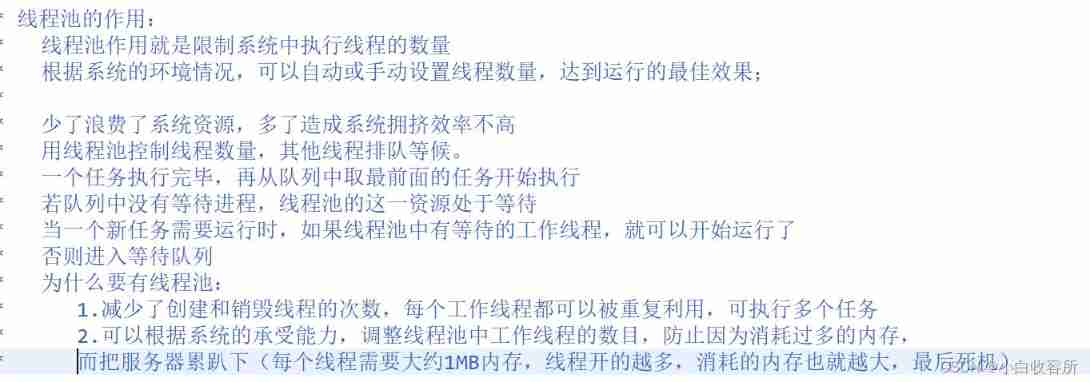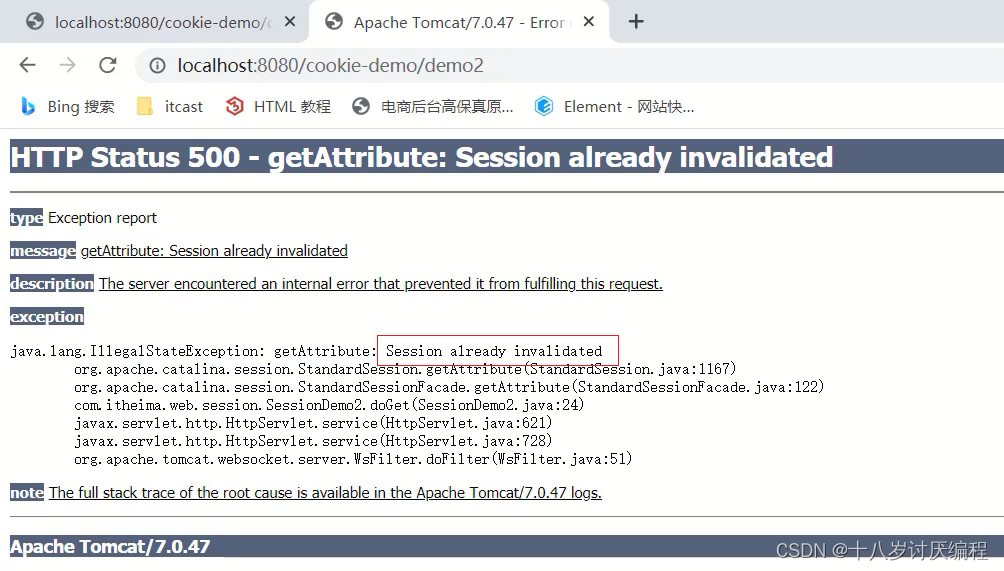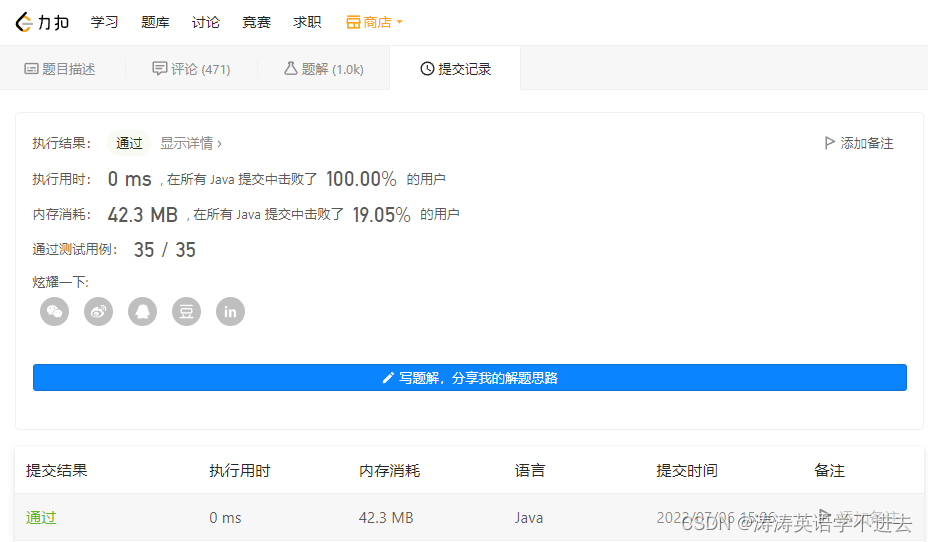当前位置:网站首页>Day22 deadlock, thread communication, singleton mode
Day22 deadlock, thread communication, singleton mode
2022-07-07 12:48:00 【Xiaobai shelter】
1. Deadlock
1.1 summary
Deadlock : Is in the process of execution , Both encountered the other party's method of locking , This leads to a state that everyone can't access
principle : 1. The execution of a thread is completed , Two objects need to be nested and locked successively , And in the process , Lock the first object first
2. The execution of another thread is completed , Two objects need to be nested and locked successively , And in the process , Lock the second object first
3. When the first thread executes to the second object , Found locked , Can only wait for
4. When the second thread executes to the first object , Found locked , Can only wait for
1.2 Code implementation
public class Thread_01_DeadLock {
public static void main(String args[]){
Object o1=new Object();
Object o2=new Object();
Thread t1=new Thread(new Thread_01(o1,o2));
Thread t2=new Thread(new Thread_02(o1,o2));
t1.setName("t1");
t2.setName("t2");
t1.start();
t2.start();
}
}
class Thread_01 implements Runnable{
Object o1;
Object o2;
public Thread_01(Object o1, Object o2) {
this.o1 = o1;
this.o2 = o2;
}
public void run() {
synchronized(o1){
try {
Thread.sleep(100);
} catch (InterruptedException e) {
// TODO Auto-generated catch block
e.printStackTrace();
}
synchronized(o2){
System.out.println(Thread.currentThread().getName()+" Execution completed ");
}
}
}
}
class Thread_02 implements Runnable{
Object o1 ;
Object o2;
public Thread_02(Object o1, Object o2) {
this.o1 = o1;
this.o2 = o2;
}
@Override
public void run() {
synchronized (o2) {
try {
Thread.sleep(100);
} catch (InterruptedException e) {
e.printStackTrace();
}
synchronized (o1) {
System.out.println(Thread.currentThread().getName()+" Execution completed ");
}
}
}
}
2. Thread communication
2.1 summary
wait: Put the thread into a waiting state , Locks held are released
No participation or introduction 0 To wait for , Will not wake up automatically , Can only wait notify Wake up it
Can also be passed in long Type value , Be similar to sleep, It's time to wake yourself up
notify: Randomly wake up a thread waiting in the object
notifyAll: Wake up all waiting threads in the object
The above methods can only be used for member methods with locks
2.2 Usage mode
demand : Print odd and even numbers
* 1. There is a business class , There is a way to print odd and even numbers
* 2. There is a variable count Record the current number
* 3. Two threads , Call the methods of printing odd and even numbers respectively
*/
public class Thread_02_wait {
public static void main(String args[]){
// Create reference type variables Num It's a class Class is a reference type There are also array interfaces
Num num=new Num();
Thread t1=new PrintEven(num);
Thread t2=new PrintOdd(num);
t1.setName("t1");
t2.setName("t2");
t1.start();
t2.start();
}
}
// Print odd threads
class PrintOdd extends Thread{
Num num;
public PrintOdd(Num num){
this.num=num;
}
public void run(){
while(true){
num.printOdd();
}
}
}
// Print even threads
class PrintEven extends Thread{
Num num;
public PrintEven(Num num){
this.num=num;
}
public void run(){
while(true){
num.printEven();
}
}
}
// 1. There is a business class
class Num{
// There is a variable count Record the current number
int count=1;
// How to print odd numbers
public synchronized void printOdd(){
System.out.println(Thread.currentThread().getName()+"-->"+count);
count++;
// Wake up other threads , Go and inquire about even numbers
this.notifyAll();
// Has reached the awaited
try {
Thread.sleep(1000);
this.wait();
} catch (InterruptedException e) {
e.printStackTrace();
}
}
// Print even numbers
public synchronized void printEven(){
System.out.println(Thread.currentThread().getName()+"-->"+count);
count++;
// Wake up other threads , To print odd numbers
this.notifyAll();
// Has reached the awaited
try {
Thread.sleep(1000);
this.wait();
} catch (InterruptedException e) {
e.printStackTrace();
}
}
}
2.3 producers and consumers
For details, see :https://blog.csdn.net/qq_39575279/article/details/87940298
The main thing is to reduce the coupling
* 1. A business class SynStack There's a variable ,
* Used to save the number of produced elements
* 2. There is one in the business class char Array , Used to save production elements
* ( If only produce a-z These letters )
* 3. There need to be two methods in the business class , A production push, A consumer pop
* push Method It is mainly used to add data to the array
* Number to +1, Also determine whether it is full ,
* When it's full, hang up and wait
* pop Method It is mainly used to fetch the data in the array
* Number to -1, But also to determine whether the consumption is over ,
* When it's over, hang up and wait
* 4. Two threads , One is responsible for the production of , One is responsible for consumption
*/
public class Thread_03_ProducerConsumer {
public static void main(String args[]){
SynStack ss=new SynStack();
Thread p=new Thread(new Producer(ss));
Thread c=new Thread(new Consumer(ss));
p.start();
c.start();
}
}
// Producer method
class Producer implements Runnable{
SynStack ss;
public Producer(SynStack ss){
this.ss=ss;
}
@Override
public void run() {
Random random=new Random();
while(true){
char ch=(char) (random.nextInt(26)+97);
ss.push(ch);
}
}
}
// Consumer approach
class Consumer implements Runnable{
SynStack ss;
public Consumer(SynStack ss){
super();
this.ss=ss;
}
@Override
public void run() {
while(true){
try {
Thread.sleep(500);
} catch (InterruptedException e) {
// TODO Auto-generated catch block
e.printStackTrace();
}
ss.pop();
}
}
}
// Let's start with a business class
class SynStack{
// Container for saving data
char[] data=new char[6];
// Number of production
int count=0;
// production
public synchronized void push(char ch){
// Judge whether it is full
if(count==data.length){
try {
this.wait();
} catch (InterruptedException e) {
// TODO Auto-generated catch block
e.printStackTrace();
}
}
// That means it's not full , Started to produce
// Awaken consumers to prepare for consumption
this.notifyAll();
data[count]=ch;
count++;
System.out.println(" Produced "+ch+", The remaining "+count+" Elements ");
}
// Consumption method
public synchronized char pop(){
// Determine whether it is null
if(count==0){
try {
// There's no need to wake up the producers here , Because the producer is full in wait, It's all empty , It means that the producer must not wait
this.wait();
} catch (InterruptedException e) {
// TODO Auto-generated catch block
e.printStackTrace();
}
}
// This is not empty , Start spending
count--;
char ch=data[count];
// Wake up producers
this.notifyAll();
System.out.println(" The consumption "+ch+", The remaining "+count+" Elements ");
return ch;
}
}
3. The singleton pattern
The singleton pattern : Let a class instantiate only one object
The constructor is privatized , Static variables hold objects , Public static methods are used to get class objects
Hungry man mode has no problem in a multithreaded environment , Because no matter how many thread classes can only be loaded once , So it will only be initialized once ,
* This means that only one object can be created
*/
public class Thread_04_SingLeton {
private Thread_04_SingLeton(){
}
private static Thread_04_SingLeton singLeton=new Thread_04_SingLeton();
public static Thread_04_SingLeton getInstance() {
return singLeton;
}
/** * volatile : Why use volatile Well ? Prevent command rearrangement * * https://www.cnblogs.com/dolphin0520/p/3920373.html * */
private volatile static Thread_05_SingLeton singLeton = null;
// Low efficiency , Because you have to queue up every time
// public synchronized static Thread_05_SingLeton getInstance() {
// if (singLeton == null) {
// singLeton = new Thread_05_SingLeton();
// }
// return singLeton;
// }
// More efficient , Because you only need to queue for the first time
public static Thread_05_SingLeton getInstance() {
if (singLeton == null) {
synchronized (Thread_05_SingLeton.class) {
// 1// 2
if (singLeton == null) {
singLeton = new Thread_05_SingLeton();
}
}
}
return singLeton;
}
}
4. Thread pool 
Single threaded pool (newSingleThreadExecutor) The advantages of , Serial execution of all tasks . If the only thread ends because of an exception , Then there will be a new thread to replace it
This thread pool ensures that all tasks are executed in the order in which they are submitted
边栏推荐
- test
- Common knowledge of one-dimensional array and two-dimensional array
- [疑难杂症]pip运行突然出现ModuleNotFoundError: No module named ‘pip‘
- [deep learning] image multi label classification task, Baidu paddleclas
- HZOJ #240. 图形打印四
- 编译 libssl 报错
- Four functions of opencv
- Master formula. (used to calculate the time complexity of recursion.)
- [learn micro services from 0] [02] move from single application to service
- Visual stdio 2017 about the environment configuration of opencv4.1
猜你喜欢

Customize the web service configuration file

Pule frog small 5D movie equipment | 5D movie dynamic movie experience hall | VR scenic area cinema equipment

Dialogue with Wang Wenyu, co-founder of ppio: integrate edge computing resources and explore more audio and video service scenarios

MPLS experiment

BGP actual network configuration

Static routing assignment of network reachable and telent connections

ICLR 2022 | pre training language model based on anti self attention mechanism

leetcode刷题:二叉树24(二叉树的最近公共祖先)

Session

Leetcode question brushing: binary tree 26 (insertion operation in binary search tree)
随机推荐
Leetcode question brushing: binary tree 26 (insertion operation in binary search tree)
Realize a simple version of array by yourself from
JS to convert array to tree data
Preorder, inorder and postorder traversal of binary tree
[pytorch practice] use pytorch to realize image style migration based on neural network
ps链接图层的使用方法和快捷键,ps图层链接怎么做的
广州市召开安全生产工作会议
[statistical learning methods] learning notes - improvement methods
Leetcode brush question: binary tree 24 (the nearest common ancestor of binary tree)
[statistical learning method] learning notes - logistic regression and maximum entropy model
2022 polymerization process test question simulation test question bank and online simulation test
Realize all, race, allsettled and any of the simple version of promise by yourself
数据库安全的重要性
Session
【统计学习方法】学习笔记——提升方法
Aike AI frontier promotion (7.7)
Creation and assignment of graphic objects
ICLR 2022 | 基于对抗自注意力机制的预训练语言模型
leetcode刷题:二叉树26(二叉搜索树中的插入操作)
利用棧來實現二進制轉化為十進制